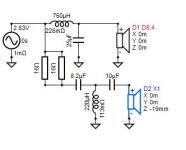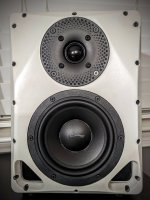The best sounding speakers I have built to date work to listener's satisfaction (and also mine) when tuned by ear. They are 4 way actively run speakers with separate cabinets for each section and a 4 way LR analogue crossover. When I tweak the crossover for REW to submit a flat line, I don't like the results as much I like them tweaked by the ear. I can relate and agree to your post.The loudspeakers were tuned by ear and initially, over time and after many different listening impressions, it sometimes became necessary to tweak the crossover slightly.
I’m in that situation now. I built a pair of speakers for the AKfest and finished them the night before the fest. I built simple crossovers with junk I had laying around and love the sound for the last 12 years.
I keep wondering if I should do full blown crossovers but not sure if they would sound any better.

I keep wondering if I should do full blown crossovers but not sure if they would sound any better.
How high are you running the 15?……I have run mine all the way up to 1khz without issue……i have even put a frost order low pass on them with an 8” mid woofer………waaaaay to big a speaker but man did it sound good!For big sound there is a sub with an Mivoc AWX184 in an GHP configuration
The Faital 15PR400 running up to 600 Hz and down to 80 Hz, from there the 18 inch makes the rest down.How high are you running the 15?……I have run mine all the way up to 1khz without issue……i have even put a frost order low pass on them with an 8” mid woofer………waaaaay to big a speaker but man did it sound good!
This makes so much fun
Last edited:
I figured the answer would come quicker. What is the brand of this speaker, it has slipped my mind, and i referenced them in th Larsen-8 thread.
View attachment 1214611
dave
http://www.shahinianacoustics.com/DiapasonEnsemble.htm
Last edited by a moderator:
The 4 x 6,5 inch woofers are not produced anymore, it are the Sonic 60/120 with a styrophome dome and long excusion. The Fs is about 30 Hz. I tried the dome midrange Dynaudio D54 as open baffle but did not like the results. The opening on the back is a round vent and the sound does not come out well dispersed. Beside that, the soundstage is already wide and deep but i will test it with a second backfiring planar tweeter this year.This is awesome. Can you provide some more details on the down firing 6.5inches woofers working as a sub- a fairly long single piece? These must really sound too good. And I think the midrange on the top is open baffle? Presumably the sound stage should be quite good with that.
Last edited by a moderator:
Sweet ..I‘ve made a mistake, the driver is the Hf1440 not the Hf1400.
Some more pictures
View attachment 1211713 View attachment 1211714 View attachment 1211715 View attachment 1211716
amazing effort love the way you've managed to make the felt look modern and like a high end commercial productIt's been almost three years since I broke down my last system to start building this. Building the cabinets and getting them finished like this took almost half a year. The project also was on hold for a long time because I lived somewhere else for a year and also saving money and acquiring all the gear took a long time. This summer vacation I moved back in with my parents and finally got back to it. I made got the last cables and did all the finishing touches to the speakers, measuring and tuning just last week.
Speakers:
-H: BliesMa T34B-4
-M: SB-Acoustics Satori MR16P-4
-L: 2 × SB-Acoustics Satori WO24P-8
System:
Source: MiniDSP SHD Studio
DAC: NuPrime DAC-9SE
Amps:
-H: Purifi EVAL-1
-M/L: Hypex FA502
Netfilters: NuPrime AC-4
Cabling: all DIY Furutech power and interconnects, Sharkwire Musical Love speaker cables (int. and ext.).
It's an active DSP controlled system. The MiniDSP is a network streamer with on-board DSP with two digital outputs. One feeds through the NuPrime DAC into the Purifi amp which powers just the tweeters. The other output goes into the master Hypex amp which feeds through to the slave. One channel of each amp powers the midrange, the other the woofers. Yes the power figures are absolutely stupid. 400 Watts for each tweeter, 500 Watts for each midrange and 500 Watts for each pair of woofers. I absolutely don't need all this power but I wanted to use a very high quality amp for the tweeters which the Purifi most definately is. And it just happens to be 400 Watts. I did purposely choose the biggest FusionAmp model because they are a lot quieter. All this excessive power is a nice thing anyway because the system can perform while Amps are always at ease playing with low distortion and great control.
The speakers are made out of 25 mm HDF. I designed them in CAD and got all the panels CNC cut. The inside of the sealed bass enclosure is reinforced by 8 internal panels which are placed pointing away from the centre of the opposed woofers. This way the woofers cancel each others forces and the cabinet stays completely quiet at any volume.
The midrange chamber is the entire trapeze shaped part. A very large volume so that the midrange can move completely free. There are no braces in the midrange chamber. Instead the sides are reinforced by 10 mm aluminum plates pressed against the HDF with bitumen and a rubbery adhesive in-between. This way the side panels are extremely rigid and quite well damped and there are no reflective surfaces right behind the midrange. Internally the back of the midrange chamber is triangular which together with the slanted sides goes against standing waves. It's also stuffed with natural wool. The bass cabinets are stuffed with Knauf Acoustifit. The speakers sit on IsoAcoustics Gaia II damping feet (they are right on the weight limit 😅).
The trapezoid top together with the bevelled edges and felt lined baffle work greatly to make on- and off-axis response very smooth with little defraction and baffle reflections. And I have to say I was quite proud of myself when I saw the first measurments (these were done in the living room not in this small space). The red graph is a RTA measurment after time alignment. The lower frequencies are obviously bumpy in the measurment but the mid and high frequencies were already very smooth IMO. The blue line is on axis gated measurment after just a few tweaks in the EQ. Maybe a little bright but this was just a base. Green is ~60⁰ off-axis. I was also very impressed by the linearity off-axis. No real big peaks or dips even very far off-axis. Crossover frequencies are 250 Hz and 2,6 kHz.
After the speakers were reasonable flat I set up the system in my room, redid the time alignment on the listening position and decided the toe-in angle so that the sound disconnects from the speakers so the soundstage goes wider than the speakers. Then I finished up the tuning by Dirac Live calibration on the MiniDSP. Wow does that save a lot of time and wow does it give magnificent results. This is the way I will forever calibrate my speakers.
The electronics don't have many hours on them yet but it's no problem.
The sound is incredible. Exactly what it was among for. The lows are probably the tightest and most linear I have ever heared. And the go all the way down. I set Dirac to EQ them flat (-0 dB not -3 dB) down to 17 Hz and I know these speakers are capable of that and it shows. While playing hard techno I think the bass packs a much harder hitting punch with these bigger amplifiers than i remember from before. Mid's are very free with great clarity and body. That paper Satori just sounds so wonderfully organic/natural and that big chamber with proper damping really let's it sing unrestricted.
The driver that really shines though is the tweeter. This beryllium BliesMa is with no doubt the best dome tweeter on the market. Before this I had the SB-Acoustics Satori TW29BN. Already one of the top beryllium tweeters on the market. This BliesMa is on a whole other level in terms of speed, detail and soundstaging. I'm not exaggerating when I say it is a night and day difference. I did get to compare the difference when I already tried them in the last speakers.
All together the sound is very complete. Obviously extremely linear. Very fast transient response and tightness from top to bottom. Extremely low distortion. Great naturality and body. And most impressive are the tremendously deep and wide soundstage and the absurd detail. There is not a sound in any recording that can hide. I'm hearing things I didn't even hear before on my previous system or Campfire Holocene IEM's with iFi Gryphon DAC. I'll put this system up against any system up to €100k.
I'm gonna be satisfied for a long time.
A little 3d printed, epoxy filled HiVi Research (Swans) project. D5.4 and X1-II. Kept component count low, but result is a not so great reverse-null. Didn't bother attenuating the top end of the tweeter.
Thoughts - The woofer is a nice little unit that performs really well, but may be priced a bit high. Not sure I like the Swans logo. The tweeter leaves something to be desired due to the increasing high end that I didn't want to pad down (see comment above). It does look cool though and performance is decent. Side note: HiVi's spec sheet for the tweeter doesn't show the rise, so it may be my baffle shape. I did test an SB26STAC in it's place and it does not exhibit the rise the X1 does, but ultimately chose the X1 just because I wanted to use a different driver and again, I thought it looked cool. In this case, I followed form over function.

Thoughts - The woofer is a nice little unit that performs really well, but may be priced a bit high. Not sure I like the Swans logo. The tweeter leaves something to be desired due to the increasing high end that I didn't want to pad down (see comment above). It does look cool though and performance is decent. Side note: HiVi's spec sheet for the tweeter doesn't show the rise, so it may be my baffle shape. I did test an SB26STAC in it's place and it does not exhibit the rise the X1 does, but ultimately chose the X1 just because I wanted to use a different driver and again, I thought it looked cool. In this case, I followed form over function.
Attachments
@djn - there is definitely content into the 50Hz range and are okay for "fullrange" listening if there is not a lot of content in the subwoofer frequency ranges. A subwoofer is always nice to add in. They play pretty loud, but distortion figures start rising below 80Hz-ish. Xmax on the D5.4 is listed as 3.5mm, so the drivers themselves are pretty limited. It's a good pair for a smaller room or office. They could do well in a larger room, but need to be highpassed in that case.
Thoughts - The woofer is a nice little unit that performs really well, but may be priced a bit high.
It's the heritage from knocking off vintage Dynaudio drivers, nowadays made with smaller mods to the original.
Hi all,
after some back and forth of testing with different setups in the only room i have to listen to music i have abandoned the huge construction posted earlier here:
https://www.diyaudio.com/community/threads/ultimate-open-baffle-gallery.123512/post-7393996 and come to some evaluation of what is useable when the goal is to keep the open baffle as small as possible.
Here my setup:
ROON Server -> Pro-Ject Stream Box S2 Ultra -> miniDSP 2X4 HD as DAC with USB Input and Subwoofer Digital Active Crossover and Hypex FA123 Plate Amps for the high Woofer the mid horn and the super-tweeter.
Here the pics:
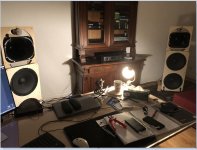
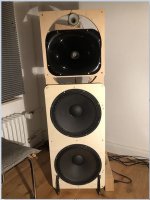
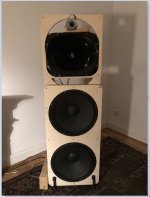
Setup of the active crossover has been done in the first place to avoid loud chirp noise from the CLIO measurement equipment only with my ears, here:
Lower woofer LP 70 Hz BW2
Higher woofer HP 20 Hz LP 350 Hz CH1 Hypex FA123
Mid horn HP 400 Hz Bessel 2nd order LP 6000 Hz Bessel 2nd order CH2 Hypex FA123
Super-tweeter Visaton TL16H HP 6000 Bessel 2nd order CH3 Hypex FA123
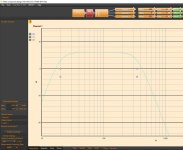
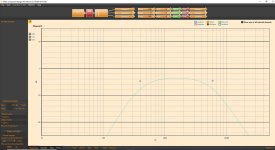
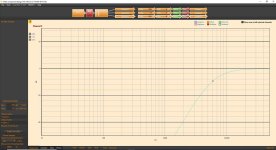
to get some decent low frequency effects out of the very small open baffle i needed to cut off the lower woofer very deep with 70 Hz and to rise the volume about +9 dB to the high mounted woofer, that's the trade off of the very small baffle.
Here the chassis:
low mounted woofer Celestion FTR15-3070C
high mounted woofer Celestion FTR15-3070C
midrange horn Eighteensound XT1464 with B&C DCM14-16 driver
super-tweeter Visaton TL16H
so far - so good, Stefano
after some back and forth of testing with different setups in the only room i have to listen to music i have abandoned the huge construction posted earlier here:
https://www.diyaudio.com/community/threads/ultimate-open-baffle-gallery.123512/post-7393996 and come to some evaluation of what is useable when the goal is to keep the open baffle as small as possible.
Here my setup:
ROON Server -> Pro-Ject Stream Box S2 Ultra -> miniDSP 2X4 HD as DAC with USB Input and Subwoofer Digital Active Crossover and Hypex FA123 Plate Amps for the high Woofer the mid horn and the super-tweeter.
Here the pics:



Setup of the active crossover has been done in the first place to avoid loud chirp noise from the CLIO measurement equipment only with my ears, here:
Lower woofer LP 70 Hz BW2
Higher woofer HP 20 Hz LP 350 Hz CH1 Hypex FA123
Mid horn HP 400 Hz Bessel 2nd order LP 6000 Hz Bessel 2nd order CH2 Hypex FA123
Super-tweeter Visaton TL16H HP 6000 Bessel 2nd order CH3 Hypex FA123



to get some decent low frequency effects out of the very small open baffle i needed to cut off the lower woofer very deep with 70 Hz and to rise the volume about +9 dB to the high mounted woofer, that's the trade off of the very small baffle.
Here the chassis:
low mounted woofer Celestion FTR15-3070C
high mounted woofer Celestion FTR15-3070C
midrange horn Eighteensound XT1464 with B&C DCM14-16 driver
super-tweeter Visaton TL16H
so far - so good, Stefano
Hi folks,
continuation of this here - https://www.diyaudio.com/community/threads/system-pictures-description.23208/post-7494338
Some more listening tests, used Roon DSP to correct some nasal sound coming from the midrange horn, sounds better now, speaker setup is absolutely required since my desk in the home office is far outside the optimal listening position with the left box much closer than the right one
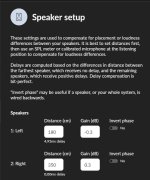
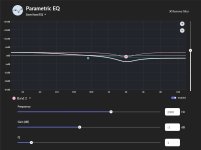
continuation of this here - https://www.diyaudio.com/community/threads/system-pictures-description.23208/post-7494338
Some more listening tests, used Roon DSP to correct some nasal sound coming from the midrange horn, sounds better now, speaker setup is absolutely required since my desk in the home office is far outside the optimal listening position with the left box much closer than the right one


Hi all,
this is my current horn loaded 3 ways system. It is composed of RCF LF21X451 + "Myhorn", JBL 2441 + 2360A, JBL2404H
"Myhorn" is self made, composed of the main box (100 x 90 x 62) and a shelf supporting audio devices (250 x 36 x 62) only one side. It is still under construction, was designed with help of Ansys (still learning the acoustic module) and Hornresp; mesurements with REW
the measurement and hearing are very nice. The lower frequency going down to 20 Hz. The two horns perfectly matching in tone.
It is compression + bass reflex with 4 different length tubes (PVC pressure 4.5 mm thickness). There is a commercial phase plug increasing compression ± from 4 to 5. The horn curve is made of 2 x 9 mm panels. It is nor finished (see pics )
)
I could check that it is possible to avoid peak resonance with the different tubes 'easy to change)Active filters with 3 amplifiers and adjustment of levels (100 - 111 -105 dB 1W 1m).
The amplifiers will be raplaced by tubes, the 1st an ARC D115 (half 6550 tubes removed speakers connected to half they rated Z)




this is my current horn loaded 3 ways system. It is composed of RCF LF21X451 + "Myhorn", JBL 2441 + 2360A, JBL2404H
"Myhorn" is self made, composed of the main box (100 x 90 x 62) and a shelf supporting audio devices (250 x 36 x 62) only one side. It is still under construction, was designed with help of Ansys (still learning the acoustic module) and Hornresp; mesurements with REW
the measurement and hearing are very nice. The lower frequency going down to 20 Hz. The two horns perfectly matching in tone.
It is compression + bass reflex with 4 different length tubes (PVC pressure 4.5 mm thickness). There is a commercial phase plug increasing compression ± from 4 to 5. The horn curve is made of 2 x 9 mm panels. It is nor finished (see pics
I could check that it is possible to avoid peak resonance with the different tubes 'easy to change)Active filters with 3 amplifiers and adjustment of levels (100 - 111 -105 dB 1W 1m).
The amplifiers will be raplaced by tubes, the 1st an ARC D115 (half 6550 tubes removed speakers connected to half they rated Z)
- Home
- Loudspeakers
- Multi-Way
- System Pictures & Description


